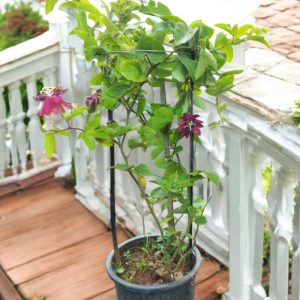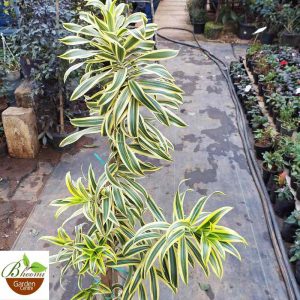Passion flowers may look like they are from the tropics, but they can actually be grown almost anywhere, including much colder areas. In fact, you may even find these seemingly delicate vines growing along the side of the road—some passionflower species can spread vigorously in warmer climates. The genus Passiflora is native to North America and South America and contains more than 500 species, so the common name passionflower can actually describe many different plants. Typically, they should be grown in full sun to partial shade, in average, but well-drained soil. A sheltered location such as against a garden wall, is recommended for many species, which can be damaged by major winds or harsh weather.
The Purple Passion Flower, also known as Krishna Kamal (Passiflora incarnata), is a stunning vine with exotic-looking, purple-hued flowers. This plant is native to the southeastern United States but is widely cultivated worldwide for its ornamental beauty and medicinal properties. Here’s a comprehensive guide to caring for the Purple Passion Flower:
1. Light Requirements
- Full Sun to Partial Shade: Purple Passion Flower thrives best in full sun but can also tolerate partial shade. Aim to provide at least 4-6 hours of sunlight daily.
- Avoid Complete Shade: Too much shade can reduce flowering and slow down growth, so make sure it gets enough light.
2. Watering
- Keep Soil Moist but Not Soggy: Water regularly to keep the soil evenly moist, especially during the growing season (spring and summer).
- Deep Watering: Ensure the water reaches the plant’s roots by watering deeply. However, avoid waterlogging, as this can lead to root rot.
- Reduce Watering in Winter: In the dormant period (late fall and winter), reduce the watering frequency.
3. Soil
- Well-Draining Soil: The plant prefers well-draining, fertile soil. A mixture of garden soil, compost, and sand works well.
- Slightly Acidic to Neutral Soil pH: A pH range of 6.1 to 7.5 is ideal. You can add organic matter to the soil to improve its fertility and structure.
4. Temperature and Humidity
- Warm Temperatures: Purple Passion Flower thrives in temperatures between 60-85°F (15-30°C). It can tolerate brief periods of cooler temperatures but not freezing conditions.
- Frost Protection: If you live in a region with cold winters, consider growing it in a pot to bring indoors or provide frost protection.
- Moderate to High Humidity: The plant enjoys moderate to high humidity levels. If growing indoors, mist the leaves occasionally to maintain humidity.
5. Fertilizing
- Balanced Fertilizer: Feed the plant with a balanced, water-soluble fertilizer (e.g., 10-10-10) every 4-6 weeks during the growing season.
- Organic Alternatives: You can also use organic compost or well-rotted manure to enrich the soil naturally.
6. Support and Pruning
- Climbing Support: Purple Passion Flower is a climbing vine, so provide a trellis, fence, or another structure for it to climb.
- Regular Pruning: Prune in late winter or early spring to control its size and shape. Remove dead, damaged, or weak stems to encourage new growth.
- Training the Vine: Regularly train the vine by tying new growth to the support structure to guide its direction.
7. Propagation
- Seeds: You can grow Purple Passion Flower from seeds. Soak the seeds in warm water for 24 hours before planting to improve germination. Plant the seeds in a seed-starting mix and keep them warm and moist.
- Cuttings: Stem cuttings are an effective method for propagation. Take 4-6 inch cuttings from healthy, non-flowering stems. Place the cuttings in water or moist soil, ensuring that at least one node is submerged. Roots should form in a few weeks.
8. Pests and Diseases
- Common Pests: Watch out for aphids, spider mites, and whiteflies, which can occasionally infest the plant. Regularly inspect the plant and use insecticidal soap or neem oil if needed.
- Fungal Issues: The plant may be susceptible to fungal infections like powdery mildew. Ensure good air circulation around the plant and avoid overhead watering to prevent these issues.
9. Flowering and Fruiting
- Bloom Season: Purple Passion Flower typically blooms from spring to fall, producing its signature intricate, purple flowers.
- Edible Fruit: After flowering, the plant may produce small, oval fruits that are edible. These fruits can be used in jams, jellies, or consumed fresh.
10. Cultural Significance
- Religious Symbolism: In some cultures, the flower is associated with religious and spiritual symbolism. For example, in India, it is known as Krishna Kamal and is linked to Lord Krishna.
By following these care guidelines, your Purple Passion Flower can flourish, adding a touch of exotic beauty to your garden or indoor space.
** Plants photos are for representation purpose only. We will make best efforts to send the plants as in photos itself, however it is not always guaranteed as plants might overgrow or shrink depending on the season, care or age. Trust us, we want to give you the best.














Reviews
There are no reviews yet.